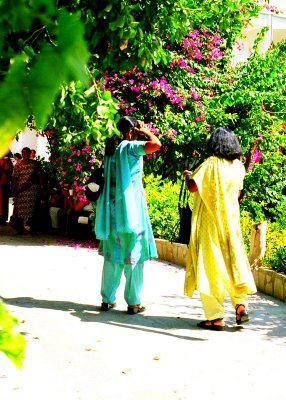The old walled city in Nicosia is awash with Saris on Sunday mornings. But not for much longer.
I LOOKED UP FROM MY BREAKFAST one Sunday morning, and saw sari-clad women streaming past my hotel. Had I been magically transported back to Asia? This was the first weekend when I hadn’t escaped the searing Nicosia heat for the slightly more comfortable coastline. I hadn’t noticed these women during the week because most of them work as maids in Greek Cypriot households, and Sunday is their day off. I soon learned that as a new member of the European Union, Cyprus has a few years to “harmonize” it’s employment laws with the older EU countries. Then EU citizens will have the same freedom to work here as elsewhere in the Union—and these South Asian women will be heading home. The Greek Cypriot foreign ministry confirmed that their current work visas will be honored, but not renewed. In a few years, the women you see here skirting through Nicosia’s narrow cobblestone passageways in their colorful saris will probably be replaced by Polish or Latvian young women in faded jeans and tank tops.


Apparently, most of these women were from Sri Lanka. Based on my informal observations of their Sunday routine, many of them were Christians, who make up less than 10 percent of the Sri Lankan population. They attended the Holy Cross Catholic Church, which is technically located within the Green Line, right near the pedestrian crossing between the two sides. The two photos above were taken at a gathering in the church courtyard after Sunday services. The protestants among them could be heard singing hymns from the second floor of a nearby building, with a banner for the “Sri Lankan Christian Fellowship of Cyprus” flapping from the balcony.


The Sri Lankan community lives in one of the most historic parts of the old walled city. In the two photos above, you see the women walking through Paphos Gate, one of 10 original portals in the 16th Century Venetian ramparts that surrounded Medieval Nicosia. In 1963, the first intercommunal struggle between Greek and Turkish Cypriots centered around Paphos Gate, and the scars of war can still be seen on nearly every block. Greek Cypriots don’t want to live here anymore, certainly not in the mostly unrenovated building stock. It’s difficult to say what the Sri Lankan guest workers make of this storied neighborhood. On the face of it, their culture appears to be far removed from that of the Greek Cypriots; but in fact, their histories bear remarkable similarities. Both communities come from large, sultry island nations that have endured centuries of internal strife and colonisation.

The Sri Lankan women that I observed over several Sundays during the summer of 2005 appeared to have fallen into a comfortable routine in their temporary home. They spent their day off attending Sunday mass, going to the hairdresser’s, or taking a walk in the park. The two women above are strolling through a municipal park that is just ouside of Paphos Gate. It’s a pleasant enough spot, with a large aviary that fills the park with bird calls day and night. But it is only a few yards from here to the United Nations-monitored buffer zone, which tynges this bit of municipal greenery with an edge of sorrow.
tCr











